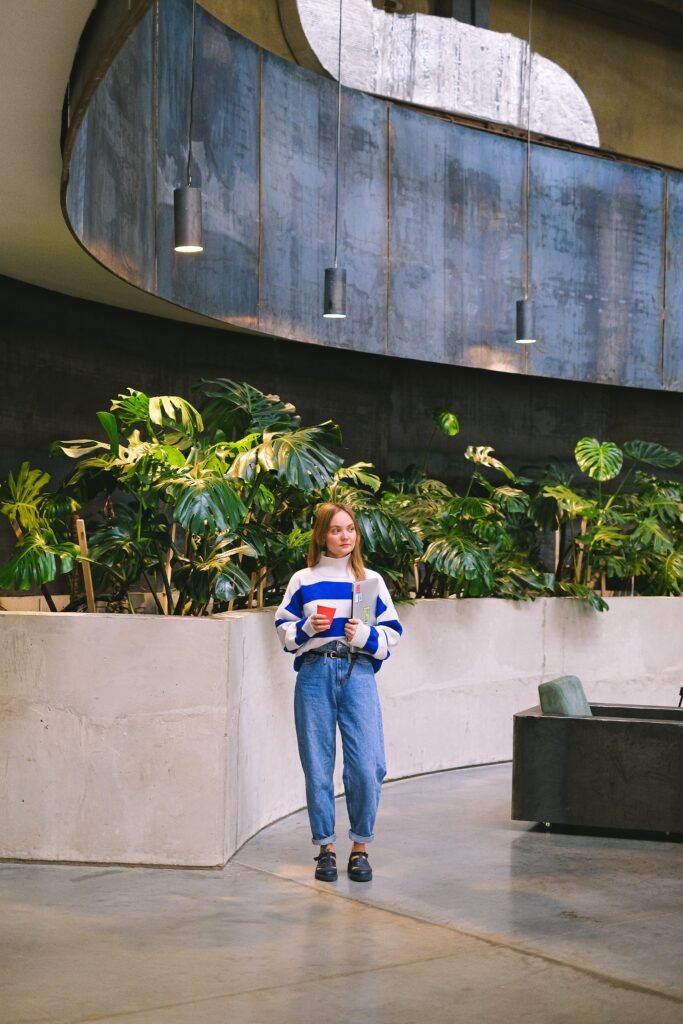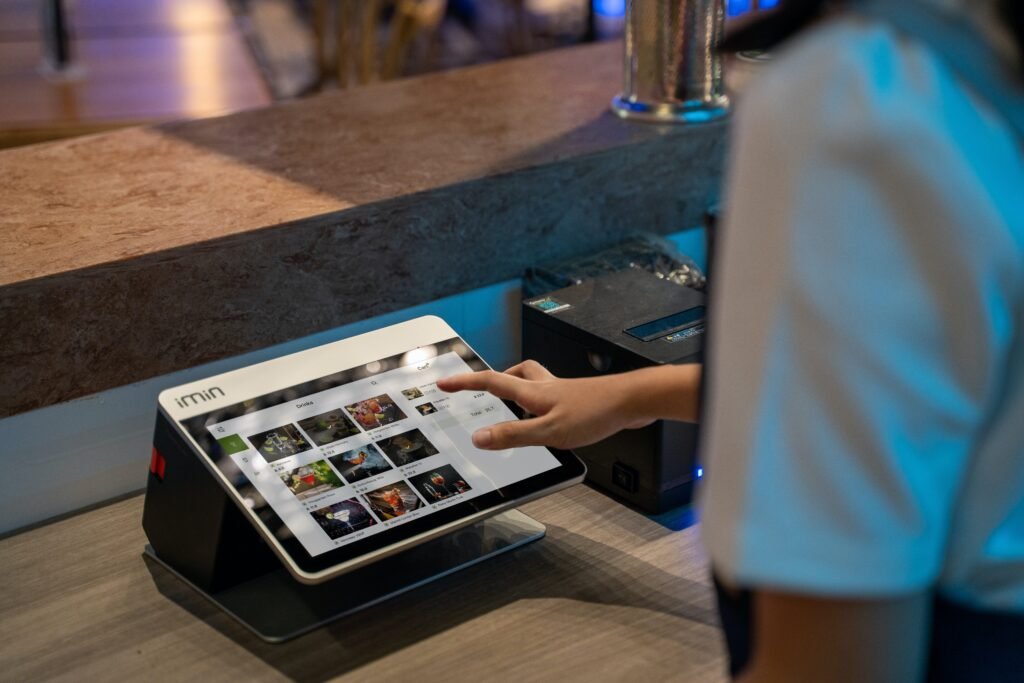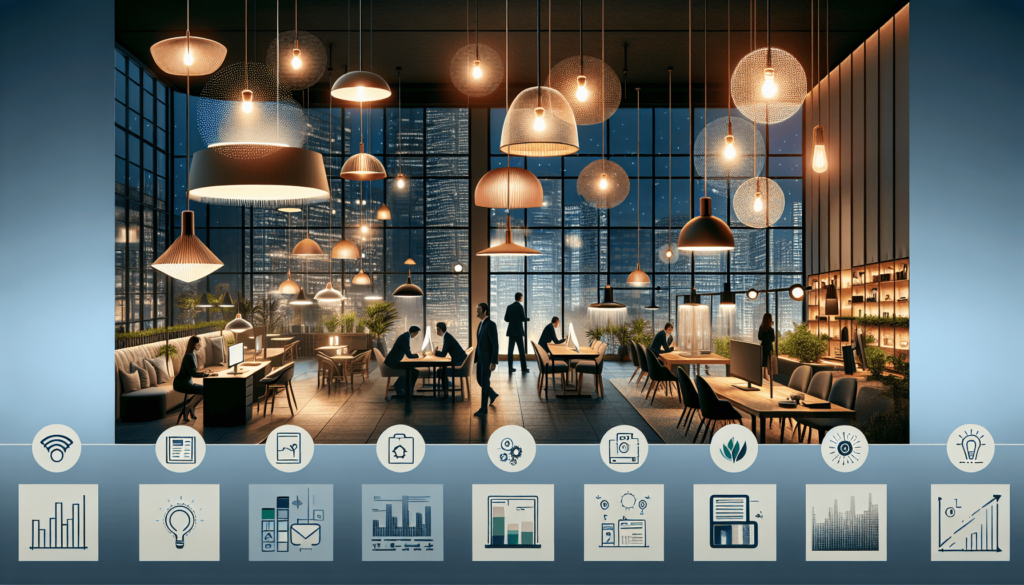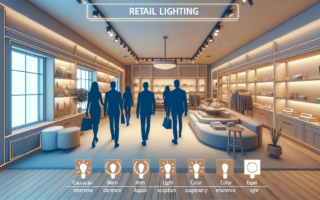In this article, you will embark on a journey to explore the vast realm of commercial lighting applications. From offices and retail spaces to warehouses and outdoor areas, the possibilities of lighting solutions are endless. Whether you are a business owner seeking to enhance your workspace or a curious individual intrigued by the world of lighting, this article will serve as a friendly guide, shedding light on the various applications and benefits of commercial lighting. So, fasten your seatbelt and get ready to discover the illuminating world of commercial lighting!
Hospitality Industry
Restaurants
In the hospitality industry, restaurants play a crucial role in providing a pleasant dining experience for their customers. Lighting in restaurants can greatly impact the ambiance and overall atmosphere of the establishment. From soft and warm lighting for a cozy and intimate setting to bright and vibrant lighting for a lively and energetic atmosphere, restaurant owners and managers have the opportunity to create the perfect lighting scheme that aligns with their brand and target audience. Proper lighting not only enhances the aesthetics of the space but also influences customers’ moods and perceptions of the food.
Hotels
Hotels are known for their luxurious and inviting environments, and lighting plays a vital role in creating an atmosphere that promotes relaxation and comfort. From the grand chandeliers in the lobby to the bedside lamps in each room, a well-designed lighting scheme can transform a hotel into a welcoming haven for guests. Hotels often utilize a combination of ambient, task, and accent lighting to create the desired ambiance in different areas, such as reception areas, hallways, restaurants, and guest rooms. Lighting fixtures in hotels are not only functional but also serve as decorative elements that add to the overall aesthetic appeal.
Bars
When it comes to bars, lighting is crucial in setting the desired mood and enhancing the overall experience. Whether it’s a trendy cocktail bar or a cozy neighborhood pub, the right lighting can create an atmosphere that attracts customers and encourages them to stay longer. Dimmed lighting with a warm color temperature is often used to create a relaxed and intimate ambiance, while brighter lighting may be employed in areas such as the bar counter to ensure visibility during drink preparation. Using lighting techniques, such as spotlighting or wall washing, can help highlight features like unique artwork or the backlit liquor shelves, adding a touch of sophistication to the space.
Nightclubs
Nightclubs are known for their vibrant and energetic atmosphere, and lighting is a critical component in creating the ultimate party experience. Lighting in nightclubs often involves a mix of high-intensity strobe lights, moving spotlights, and colorful LED fixtures that pulse and change with the music. These dynamic lighting effects, combined with fog machines and lasers, create an immersive environment that keeps the crowd engaged and energized. Proper lighting design can enhance the dance floor, highlight the DJ booth, and create visually stunning effects that contribute to the overall excitement of the nightclub.
Retail Stores
Supermarkets
Lighting in supermarkets is essential for a variety of reasons. It not only highlights the products on display but also influences customers’ shopping experiences. Well-lit spaces can make customers feel safe and comfortable, while inadequate lighting can lead to a negative perception of the store. Supermarkets typically use bright and uniform lighting to ensure visibility and easy product identification. Energy-efficient LED lighting solutions are commonly employed to illuminate both the aisles and the shelves, with specific attention given to areas like the produce section and the checkout counters to optimize visual appeal.
Fashion Boutiques
In fashion boutiques, lighting serves a dual purpose: showcasing the products and enhancing the overall shopping experience. Proper lighting can bring out the vibrant colors and intricate details of clothing and accessories, attracting customers and encouraging them to actively engage with the merchandise. Stylish and adjustable track lighting is often used to create focused illumination on specific displays or mannequins, while ambient lighting sets the tone and mood of the store. The right combination of warm and cool lighting can help create a sophisticated and inviting atmosphere that aligns with the brand’s aesthetics.
Electronics Stores
Lighting in electronics stores is crucial for showcasing the latest gadgets and technology to potential buyers. These stores often utilize a combination of bright overhead lighting and specialized spotlights to highlight specific products or demo areas. Lighting fixtures with a high color rendering index (CRI) are preferred to accurately represent the true colors of electronic devices. Additionally, task lighting may be incorporated in areas where customers can test and interact with the products, ensuring optimal visibility and an immersive shopping experience.
Department Stores
Department stores are large, multi-purpose retail spaces that house a wide range of products, from clothing and home goods to electronics and cosmetics. Lighting in department stores is designed to accommodate various sections and create a cohesive shopping experience throughout the space. Different lighting techniques, such as recessed lighting, track lighting, and pendant lights, may be employed to delineate different departments and highlight specific merchandise. Proper lighting design in department stores involves balancing general illumination with focused accent lighting to create an appealing, organized, and customer-friendly environment.

Offices
Open Workspaces
Open workspaces have become increasingly popular in modern office design, promoting collaboration and flexibility among employees. Lighting in these spaces should be bright but not overly harsh, fostering productivity and comfort. Natural light is preferable, as it increases energy levels and overall well-being. Adequate artificial lighting is also essential, often achieved through a combination of overhead lighting, task lighting, and indirect lighting. Proper illumination of workstations, break areas, and meeting spaces is crucial to ensure that employees can perform their tasks effectively and comfortably.
Meeting Rooms
Meeting rooms are essential for conducting presentations, brainstorming sessions, and important discussions. Lighting design in meeting rooms should facilitate clear communication and provide a professional and engaging environment. A combination of ambient lighting and adjustable task lighting is often used to create a well-lit space with the ability to dim or adjust the lighting levels according to the specific needs of each meeting. Lighting fixtures with glare control and properly positioned lighting sources help reduce eye strain and ensure that participants can focus on the agenda at hand.
Private Offices
Private offices offer individuals a personalized and secluded workspace where they can concentrate on their tasks. Lighting in private offices should be adjustable and tailored to the preferences of the occupant. A mix of ambient lighting and task lighting is commonly utilized to create a comfortable and productive environment. Personalized lighting controls can allow the occupant to adjust the lighting levels based on their specific needs, ensuring optimal visibility and reducing eye fatigue. Additionally, incorporating natural light through windows or skylights can enhance the overall well-being and mood within the space.
Educational Facilities
Classrooms
Lighting in classrooms is crucial for creating an optimal learning environment. Well-designed lighting can improve students’ focus and concentration, while inadequate illumination can result in eye strain and decreased productivity. Classrooms often utilize natural light whenever possible, with windows and skylights strategically placed to maximize the intake of daylight. Artificial lighting is also essential, providing consistent illumination throughout the space. LED lighting fixtures that mimic natural light with a balanced color temperature can help create a comfortable and inviting atmosphere for students and teachers.
Auditoriums
Auditoriums are multipurpose spaces used for various events, including lectures, presentations, performances, and assemblies. Lighting in auditoriums should be versatile and adjustable, ensuring visibility for both the performers on the stage and the audience members. A combination of ambient lighting and stage lighting is often used to create a balanced and illuminated environment. This includes spotlights, floodlights, and followspots to highlight performers, as well as dimmable overhead lighting to provide general illumination. Proper lighting controls are crucial in auditoriums to achieve the desired effects during different events and performances.
Libraries
Libraries are spaces designed for concentrated study and research. Lighting in libraries should promote a calm and focused atmosphere while providing adequate visibility for reading materials. Natural light is highly sought after, with libraries incorporating large windows and skylights to maximize daylight. Task lighting, such as reading lamps on study tables, can be used to supplement the ambient lighting and ensure optimal illumination for individual readers. Additionally, incorporating lighting controls that allow users to adjust the lighting levels in different sections of the library can cater to individual preferences and create a pleasant environment for all.
Gymnasiums
Gymnasiums are spaces where physical activity takes place, and lighting design plays a crucial role in promoting safety and performance. Adequate illumination is necessary to ensure that participants can move around safely and effectively. High-output lighting fixtures, such as LED high bay lights, are often used in gymnasiums to provide bright and uniform illumination throughout the space. Properly positioned lighting sources and controls are employed to minimize shadows and glare, enabling athletes to perform at their best. Additionally, incorporating lighting design that enhances the aesthetic appeal of the gymnasium can contribute to a positive and motivating environment.

Healthcare Facilities
Hospitals
Hospitals are complex environments that require diverse lighting solutions to meet various needs. Lighting design in hospitals should prioritize functionality, patient comfort, and staff efficiency. Different areas, such as patient rooms, operating rooms, corridors, and waiting areas, have unique lighting requirements. Soft, warm lighting in patient rooms and waiting areas can create a calm and soothing atmosphere for patients, while bright and sterile lighting in operating rooms ensures optimal visibility for medical procedures. Energy-efficient lighting solutions, such as LED fixtures, are commonly used to reduce energy consumption and minimize maintenance needs.
Clinics
Clinics vary in size and specialization, but the primary focus remains on providing effective healthcare services. Lighting in clinics should contribute to a welcoming and calming environment for patients. Bright and uniform lighting is essential in examination rooms and treatment areas to ensure visibility and accurate diagnoses. Patient waiting areas and reception areas often utilize softer lighting to create a more relaxed setting. Task lighting may also be incorporated in areas where medical professionals administer treatments or perform minor procedures. The aim is to create an environment that promotes trust, comfort, and overall well-being for patients and staff.
Dentist Offices
Dental offices require specific lighting design to facilitate proper examination and ensure patient comfort. Lighting solutions for dental offices should provide adequate illumination for detailed dental work while minimizing shadows and glare. Bright and cool lighting is commonly used in treatment areas to improve visibility, while softer lighting in waiting areas can help patients feel more at ease. Properly positioned task lighting can enhance the dentist’s ability to effectively perform treatments and examinations. Using lighting controls, such as dimmers, can help create the right lighting environment for different procedures and patient needs.
Pharmacies
Pharmacies play an essential role in healthcare, and lighting design in these spaces should prioritize visibility, accuracy, and customer comfort. Well-lit areas are crucial to ensure accurate medication preparation and labeling. Energy-efficient LED lighting is often used to provide bright and uniform illumination on the pharmacy counter and shelves, allowing customers to easily find what they need. Lighting fixtures with a high CRI are preferred to ensure accurate color representation of medication packaging and labels. Comfortable lighting levels in waiting areas can contribute to a positive customer experience and promote a sense of trust in the pharmacy’s services.
Industrial Spaces
Warehouses
Warehouses are critical for storage and logistics, and effective lighting design is crucial to ensure safety and maximize productivity. High-intensity lighting fixtures are commonly used in warehouses to provide bright and even illumination throughout the space. LED high bay lights, with their long lifespan and energy efficiency, are popular choices for warehouse lighting. Properly positioned lighting sources and controls help minimize shadows, enabling workers to navigate the aisles and handle goods safely. Incorporating lighting solutions with motion sensors can further enhance energy efficiency by only activating the lights when movement is detected in specific areas.
Factories
Factories require robust lighting solutions that can withstand the demands of industrial environments while ensuring optimal visibility for workers. LED lighting fixtures with high durability are often used to withstand harsh conditions, such as dust, vibrations, and high temperatures. Well-designed lighting layouts, including both general illumination and task lighting, provide workers with the necessary visibility to perform their duties efficiently and safely. Lighting controls, such as timer switches or occupancy sensors, can be incorporated to maximize energy savings by automatically turning off lights in unoccupied areas or during non-working hours.
Manufacturing Plants
Manufacturing plants involve complex processes that require careful lighting design to ensure appropriate task visibility and occupational safety. Lighting fixtures with specific color temperatures may be used to highlight quality control areas or differentiate work zones. Additionally, lighting in manufacturing plants often incorporates safety features, such as emergency lighting and exit signs, to comply with local regulations and maintain a safe working environment. Regular maintenance and periodic lighting assessments are crucial in manufacturing plants to identify any potential issues and ensure that the lighting system is functioning optimally.

Outdoor Areas
Street Lighting
Street lighting is essential for public safety, ensuring visibility and reducing the risk of accidents or criminal activity during nighttime hours. LED street lighting has become increasingly popular due to its energy efficiency and longevity. Properly designed street lighting should provide adequate illumination along roadways and pedestrian pathways while minimizing light pollution and glare. Adaptive lighting solutions, such as dimming capabilities and motion sensors, can further enhance energy efficiency by adjusting the lighting levels based on traffic patterns or pedestrian activity. Street lighting design should take into account the specific needs and regulations of each municipality or urban area.
Parking Lots
Lighting plays a vital role in parking lots by enhancing visibility and providing a sense of security for drivers and pedestrians. High-performance lighting fixtures, such as LED floodlights or parking lot lights, are commonly used to efficiently illuminate a large area. Properly positioned lighting sources should minimize dark spots, shadows, and glare while optimizing uniformity and visibility throughout the parking lot. Energy-saving features, like occupancy sensors, can be incorporated to ensure that lighting is only activated when needed. Lighting design in parking lots should prioritize safety, energy efficiency, and a welcoming environment for visitors.
Parks
Parks are public spaces that serve as recreational areas for individuals and families. Lighting in parks should promote safety while encouraging visitors to enjoy outdoor activities during evening hours. Pathway lighting is essential to guide park-goers and provide visibility along walking trails, while accent lighting can highlight specific features, such as sculptures, fountains, or landscaping elements. Energy-efficient lighting technologies, such as solar-powered lights, can be utilized in parks to minimize environmental impact and reduce energy consumption. Lighting designs for parks should consider the needs of different user groups, such as joggers, families, or individuals seeking relaxation.
Sports Fields
Sports fields, including football fields, baseball diamonds, and tennis courts, require specialized lighting design to ensure optimal visibility for players and spectators. High-output lighting fixtures, such as LED sports lights or stadium lights, are often used to provide uniform illumination across the playing surface and eliminate shadows or dark spots. Lighting in sports fields should meet specific criteria, such as maintaining appropriate lighting levels for the sport being played, minimizing glare, and adhering to local regulations regarding spill light and light trespass. Properly designed lighting systems can enhance the overall sporting experience and promote safety for athletes and spectators alike.
Entertainment Venues
Theaters
Theaters provide immersive experiences for audiences, and lighting plays a significant role in enhancing performances and setting the mood. Theatrical lighting design involves a combination of spotlights, floodlights, and colored gels to create various lighting effects and support the narrative on stage. Lighting fixtures can be controlled through sophisticated systems, allowing for seamless transitions and dynamic lighting changes throughout a performance. Proper lighting design in theaters ensures visibility for actors, creates depth on stage, and complements set design, costumes, and the overall artistic vision of the production.
Music Venues
Music venues range from intimate concert halls to large arenas and stadiums, each requiring a lighting design that complements the performances and captivates the audience. Dynamic lighting effects, such as moving lights, strobes, and laser shows, are commonly used to enhance the visual experience and create an engaging atmosphere. The lighting design in music venues should consider the specific needs of different musical genres and artist performances, as well as provide appropriate lighting for audience areas, stage areas, and backstage spaces. A well-executed lighting design can elevate the overall concert experience and contribute to lasting memories for concert-goers.
Conference Centers
Conference centers are spaces designed to host large-scale meetings, conferences, and corporate events. Lighting in conference centers should accommodate a variety of activities, including presentations, panel discussions, and networking sessions. Adequate lighting is crucial to ensure visibility for both presenters and attendees, as well as for video recordings or live streaming. Lighting fixtures with adjustable intensities and color temperatures can create different atmospheres according to the event’s requirements. Properly staged lighting can also enhance the visual impact of stage sets, branding elements, and multimedia presentations, offering a professional and memorable experience for participants.

Transportation Hubs
Airports
Airports are bustling transportation hubs that require effective lighting to ensure safety, efficiency, and an exceptional passenger experience. Lighting design in airports should consider the needs of various areas, such as terminal buildings, boarding gates, baggage claim areas, and parking facilities. Illuminated signage and wayfinding systems are crucial for guiding passengers through the complex layout of an airport. Energy-efficient lighting solutions, such as LED fixtures and automated controls, can help reduce energy consumption while maintaining optimal illumination levels. Proper lighting design in airports contributes to smoother operations, increased comfort for travelers, and improved security measures.
Train Stations
Train stations serve as crucial transportation intersections, requiring clear visibility and efficient lighting solutions to provide a seamless experience for commuters. Lighting design in train stations should emphasize safety, wayfinding, and comfort for passengers. Bright lighting is essential in platforms, waiting areas, and ticketing zones to ensure clear visibility and deter potential security threats. Energy-efficient lighting fixtures and controls can help minimize operational costs and reduce environmental impact. Illuminated signage, digital displays, and proper lighting for transportation schedules assist passengers in navigating the station easily and effectively.
Bus Terminals
Bus terminals are essential for urban transportation, connecting commuters to different parts of the city. Lighting design in bus terminals should prioritize visibility, safety, and passenger comfort. Bright and uniform lighting is necessary in passenger waiting areas, boarding zones, and ticketing booths to enhance security and provide easy navigation. Energy-efficient lighting solutions, such as LED fixtures, can reduce energy consumption and maintenance costs. Properly placed lighting fixtures can minimize shadows and glare, ensuring clear visibility throughout the terminal. Lighting controls, such as motion sensors or timers, can be incorporated to further optimize energy usage based on passenger flow and activity.
Ports
Ports are vital transportation hubs for maritime industries, and effective lighting design ensures safe navigation and efficient operations. Lighting in ports includes a combination of navigational lighting for vessels, lighting for dock areas, and lighting for passenger and cargo terminals. Properly positioned high-intensity lights guide ship captains during night-time docking procedures and assist in identifying berths and navigational aids. Illuminated gangways, wayfinding signage, and general illumination in passenger terminals contribute to a comfortable and welcoming environment for travelers. Energy-efficient lighting solutions, such as LED fixtures and smart controls, can help reduce energy consumption while maintaining optimal illumination levels throughout port facilities.
Art Galleries and Museums
Art Exhibitions
Art galleries and museums showcase various art forms and artworks, emphasizing the importance of proper lighting to create an immersive and visually stunning experience for visitors. Lighting in art exhibitions should highlight the details, colors, and textures of the artworks without causing any damage or degradation. Artwork-specific lighting fixtures, such as adjustable track lights or wall washers, are used to precisely position light sources and minimize glare or shadows. Lighting controls are utilized to adjust intensities and color temperatures, allowing curators to curate the lighting environment according to specific artworks or exhibitions, enhancing the visual impact for visitors.
Sculpture Galleries
Sculpture galleries require specialized lighting design to accentuate the three-dimensional nature of the artworks and create dramatic visual effects. Lighting fixtures with adjustable beam angles and different intensities can highlight the contours, textures, and materials of sculptures. Direct lighting or grazing techniques are often used to create shadows and reveal intricate details. The positioning of lighting sources plays a crucial role in ensuring that visitors can view sculptures from different angles and appreciate their forms and craftsmanship. Proper lighting design in sculpture galleries creates an engaging and dynamic environment that captivates art enthusiasts and showcases the sculptures’ artistic qualities.
Museum Displays
Museum displays encompass various artifacts, historical objects, and interactive exhibits that require a carefully designed lighting scheme to ensure proper visibility and viewing experience. Lighting in museum displays should be tailored to the specific lighting needs of each object or exhibit, taking into account factors such as material sensitivity, color rendering, and viewers’ comfort. Adjustable accent lighting, track lighting, or fiber optics are often used to direct attention to specific items or areas, while ambient lighting provides general illumination throughout the exhibit spaces. Proper lighting design in museum displays contributes to an engaging and educational experience for visitors, allowing them to appreciate the cultural and historical significance of the artifacts on display.
In conclusion, commercial lighting applications are diverse and tailored to the specific needs and purposes of different commercial spaces. Whether it’s creating a welcoming ambiance in hotels and restaurants, enhancing visibility in retail stores and offices, or promoting safety in healthcare facilities and transportation hubs, proper lighting design is crucial. By understanding the unique requirements of each commercial space and employing the appropriate lighting techniques, commercial spaces can be transformed into inviting, functional, and visually appealing environments that cater to the needs and comfort of their occupants and visitors.



